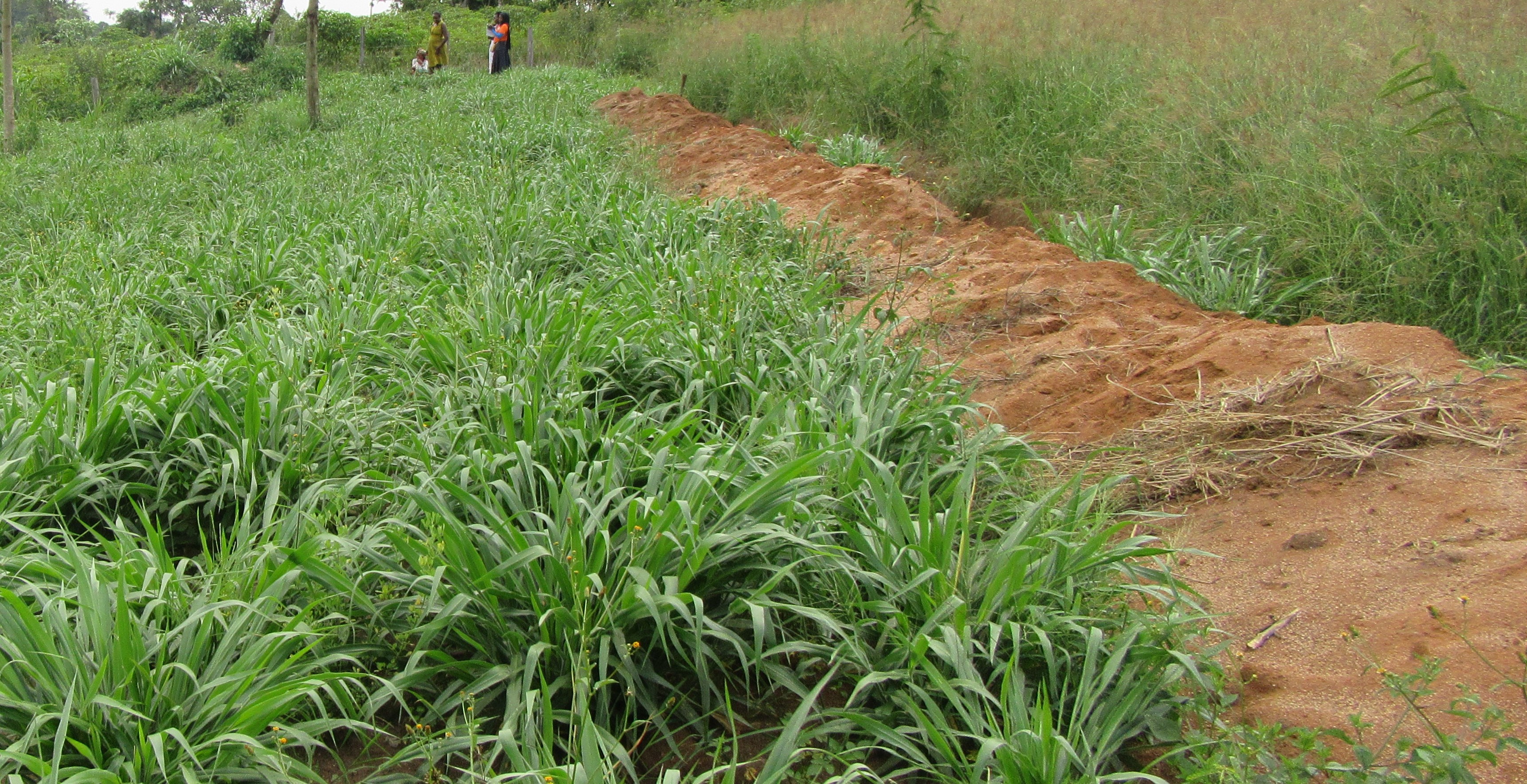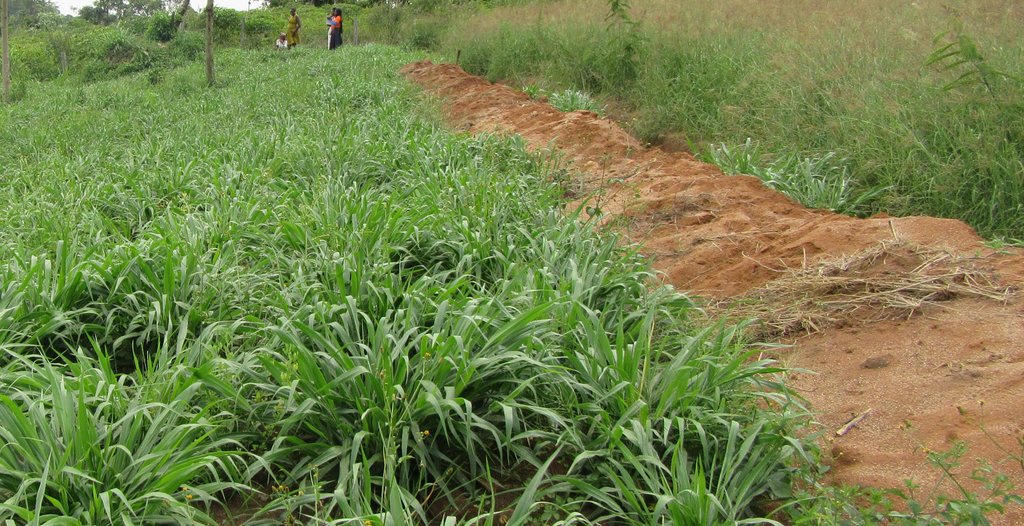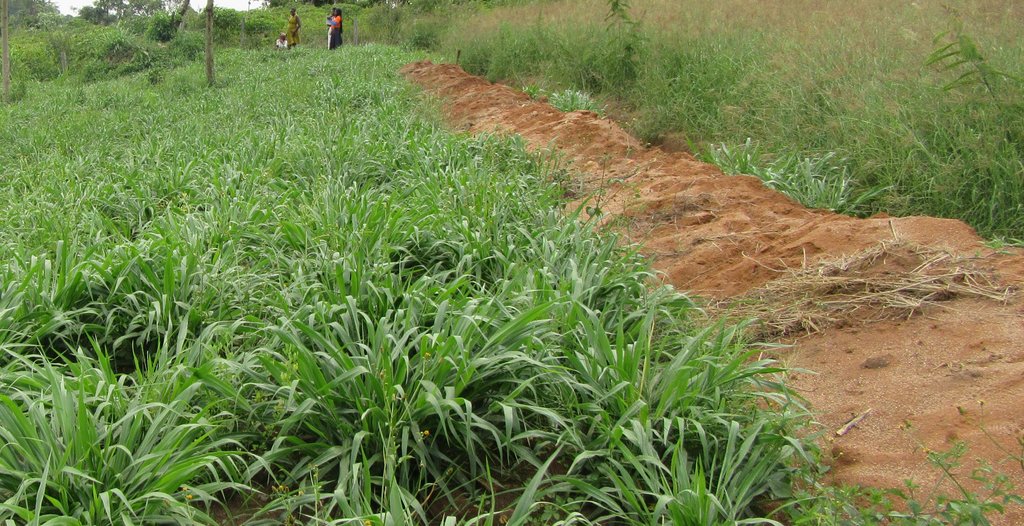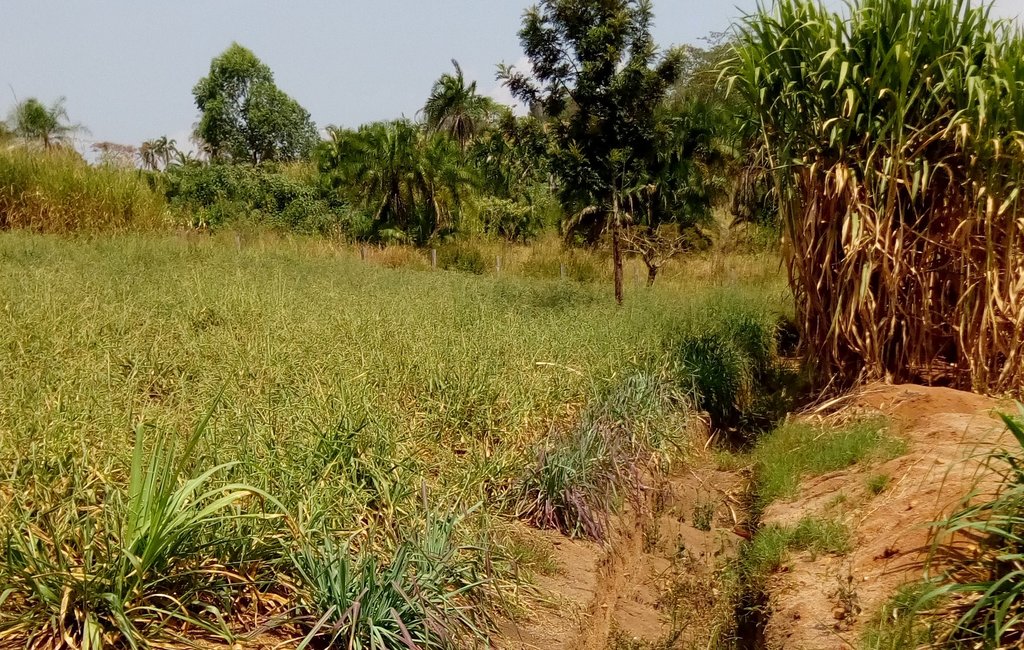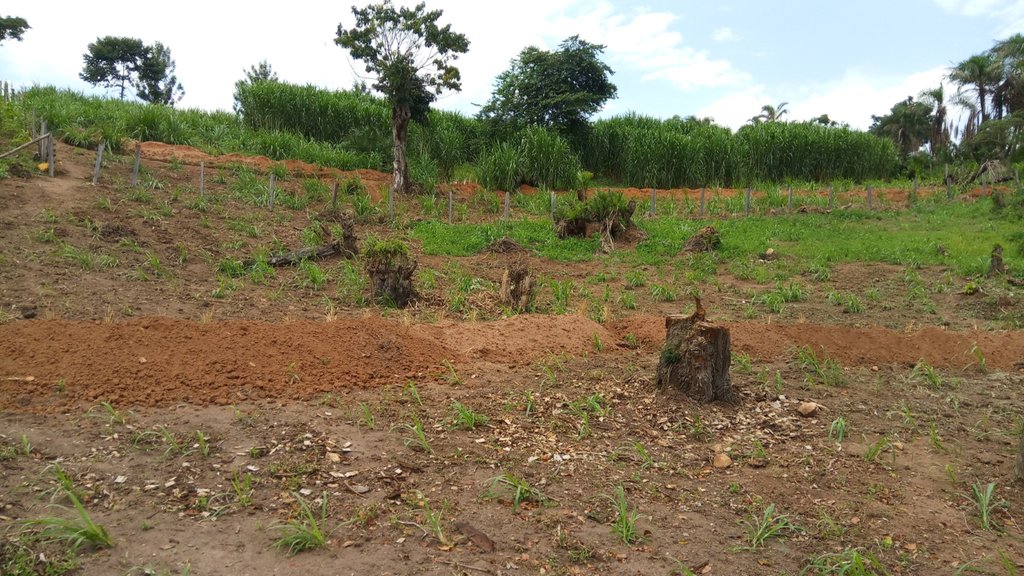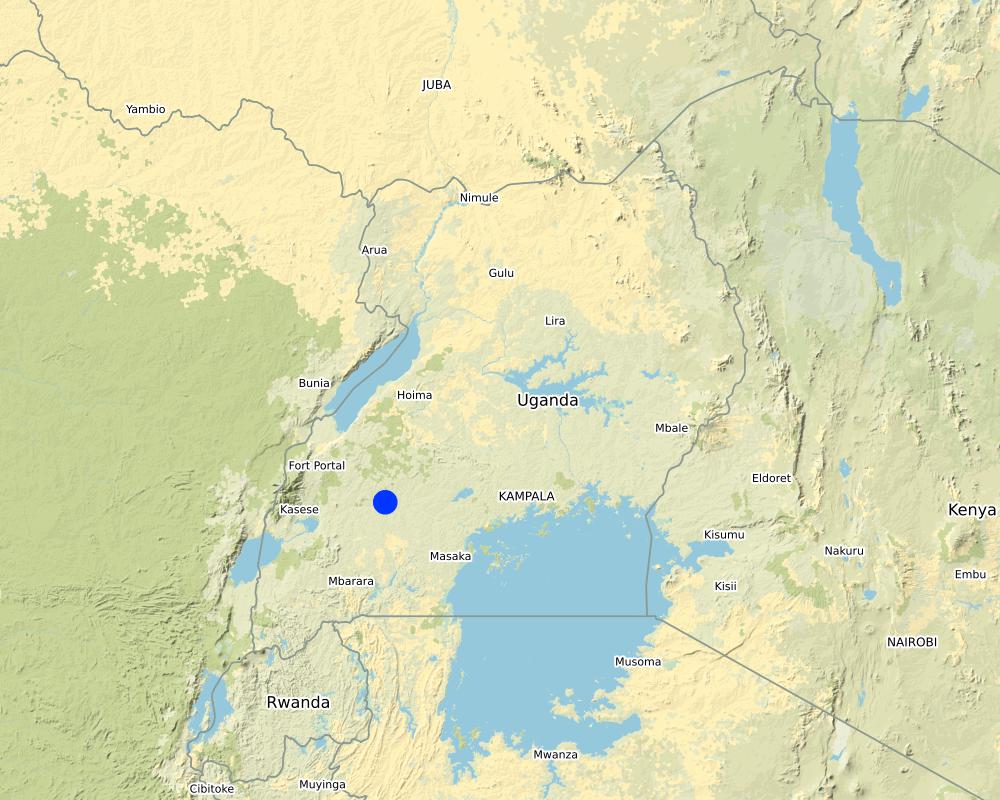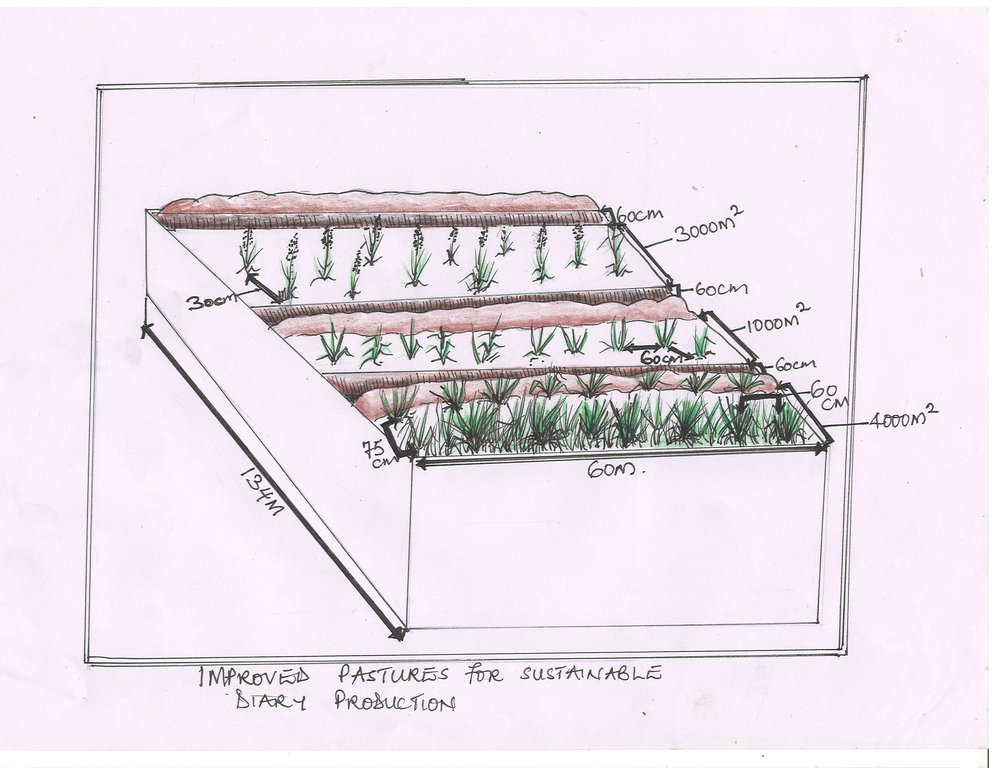Growing Improved Pastures for Sustainable Dairy Production [乌干达]
- 创建:
- 更新:
- 编制者: Jalia Namakula
- 编辑者: Kamugisha Rick Nelson
- 审查者: Nicole Harari, Udo Höggel
Ebinyansi byokurisa ente zamate
technologies_3362 - 乌干达
查看章节
全部展开 全部收起1. 一般信息
1.2 参与该技术评估和文件编制的资源人员和机构的联系方式
关键资源人
土地使用者:
Mugisha Robert
Diary for Life
Kyegeggwa District
乌干达
有助于对技术进行记录/评估的项目名称(如相关)
Scaling-up SLM practices by smallholder farmers (IFAD)有助于对技术进行记录/评估的机构名称(如相关)
National Agricultural Research Organisation (NARO) - 乌干达1.3 关于使用通过WOCAT记录的数据的条件
(现场)数据是什么时候汇编的?:
17/10/2018
编制者和关键资源人员接受有关使用通过WOCAT记录数据的条件。:
是
1.4 所述技术的可持续性声明
这里所描述的技术在土地退化方面是否存在问题,导致无法被认为是一种可持续的土地管理技术?:
否
注释:
Pastures act as fallows therefore they improve soil quality over time
2. SLM技术的说明
2.1 技术简介
技术定义:
Growing Improved Pastures (chloris gayana, brachiaria mulato and pernisetum purpurem) is a technology promoted among small, meduim scale farmers in Kyegegwa District, Western Uganda for sustainable dairy production, improved nutrition and sustainable land management.
2.2 技术的详细说明
说明:
Improved pastures comprising of fast growing nutritious grasses or legumes are generally said to be more productive than the local native pastures, because they have higher protein, carbohydrate levels and are easy to digest.
The pastures on the farm documented are established on a 2 acre piece of land located on a gently sloping area of about 20% in Kyegegwa District which experiences an average annual rainfall of about 1200 mm. The field covers the entire landscape and is neighboured by a cassava plantation. Within the same field, contour trenches were established to separate one pasture field from the other, and to also prevent soil and nutrient loss within the field. Pastures planted include Chloris gayana (rhodes grass), Brachiaria mulato (signal grass) and Pennisetum (napier grass). All grasses are native to East Africa.
Each pasture type on each plot is planted as a pure stand; the Chloris field lies on a 3000 m2 plot size, the Brachiaria field lies on 1000 m2 plot size and the Pennisetum field lies on a 4000 m2 plot size.
-Chloris gayana was planted at a spacing of 30 cm inter row and broadcasted within the rows, the seeds were mixed with sand before they were broadcasted. Thereafter the seeds were covered lightly with soils to enable easy germination of the tiny seeds.
-Brachiaria mulato was planted at a spacing of 60X 60cm
-Napier was planted at 75x 60cm.
Prior to establishment of the pastures, the plots were cleared of the bush, ploughed twice and harrowed to make a fine seed bed before planting. Two tonnes of animal manure was added. The following equipment was used:
-Hand hoes
-3 slashers
-A spirit level for leveling the contour trenches
Planting material for all the grasses was provided by the Rwebitaba Zonal Agricultural Research and Development Institute (RwebiZARDI) in form of root tillers for Brachiaria, seeds for Chloris and cuttings for the Pennisetum grass.
Kyegegwa is one of the districts where conflicts between livestock keepers and crop farmers are increasing. This kind of pressure does not allow free range grazing any more. Therefore the pastures planted were not only to provide better quality and quantity feeds for the dairy project throughout the year but also to reduce on conflicts with neighbours. Chloris gayana yields between 20-27t DM/ha and was planted to provide hay. It is drought tolerant, has a high regeneration capacity, easy to digest and is rich in carbohydrates, while Bracharia mulato is also palatable and often used in a cut & carry system. Bracharia is easy to conserve as compared to other grasses and is rich in proteins. Napier grass was planted for its early maturity, regeneration capacity, especially during the rainy season and just like Brachiaria easy to makes silage. The improved pastures are suitable for both cut & carry and grazing and they are tolerant to drought therefore providing a sustainable feed base for the diary all year round. The pastures were also planted to act as a fallow, thereby also improving soil fertility.
Establishment costs were estimated to be at UGX 1,396,000 while maintenance costs were estimated to be at UGX 320,000 per annum. Improved pastures are advantageous because they provide more nutrients than local pastures; Chloris provides more carbohydrates whereas Brachiaria and Penisetum provide more protein. Pastures rehabilitate degraded land by acting as vegetation cover for longer periods hence reducing soil erosion and increasing soil fertility. They control broad leaved weeds and a small piece of land is used to cut and carry for stock. Improved pastures require fencing as well as improved management practices such as a good soil fertility plan.
2.3 技术照片
2.4 技术视频
注释、简短说明:
Video showing improved pastures
日期:
17/10/2017
位置:
Kamwenge District, South Western Uganda
摄影师的名字:
Jalia Namakula
2.5 已应用该技术的、本评估所涵盖的国家/地区/地点
国家:
乌干达
区域/州/省:
Western Uganda
有关地点的进一步说明:
Kamwenge Town Council
注释:
The practice was established in Kyegegwa town council, Kyegegwa District, Western Uganda.
Map
×2.6 实施日期
注明实施年份:
2016
2.7 技术介绍
详细说明该技术是如何引入的:
- 通过项目/外部干预
注释(项目类型等):
The improved pastures were promoted by Rwebitaba ZARDI through the Kamwenge District Local government
3. SLM技术的分类
3.1 该技术的主要目的
- 改良生产
- 减少、预防、恢复土地退化
3.2 应用该技术的当前土地利用类型

农田
- 一年一作
主要农作物(经济作物及粮食作物):
Cassava, maize
注释:
The farm is neighboured by a cassava plantation and a maize field
如果由于技术的实施而导致土地用途发生变化,则在技术实施前说明土地利的用途。:
The field was previously used for maize cultivation
3.3 有关土地利用的更多信息
该技术所应用土地的供水:
- 混合雨水灌溉
注释:
There is a wetland at the foot of the slopes where water is drawn and used to irrigate the pastures, in addition an irrigation system is being constructed to enable sustainable pasture production.
每年的生长季节数:
- 2
具体说明:
Pastures are harvested twice a year
3.4 该技术所属的SLM组
- 畜牧业和牧场管理
3.5 技术传播
具体说明该技术的分布:
- 均匀地分布在一个区域
如果该技术均匀地分布在一个区域上,请注明覆盖的大致区域。:
- < 0.1 平方千米(10 公顷)
注释:
The field lies on 0.8 ha of land
3.6 包含该技术的可持续土地管理措施

植物措施
- V2:草和多年生草本植物
注释:
Improved pastures planted include Signal grass (Brachiaria mulato), Rhodes grass (Chloris gayana), and Napier grass (pernnisetum Purpurem)
3.7 该技术强调的主要土地退化类型

土壤水蚀
- Wt:表土流失/地表侵蚀

化学性土壤退化
- Cn:肥力下降和有机质含量下降(非侵蚀所致)

生物性退化
- Bc:植被覆盖的减少
- Bl:土壤寿命损失
注释:
The pastures are a perennial crop that act as a soil cover for longer periods of time, preventing soil and nutrient loss therefore improving soil fertility and productivity
3.8 防止、减少或恢复土地退化
具体数量名该技术与土地退化有关的目标:
- 防止土地退化
- 修复/恢复严重退化的土地
注释:
Pastures, because of their longivity, reduce soil erosion and therefore improve soil fertility
4. 技术规范、实施活动、投入和成本
4.1 该技术的技术图纸
4.2 技术规范/技术图纸说明
The technical drawing shows improved pastures established on 0.8 ha of land (8000 m2), planted with Brachiaria (planted on 1000 m2 plot size at a spacing of 60×60cm), Chloris guyana, planted on a 3000 m2 plot size at a spacing of 30cm inter row and seed broadcasted within the row. Napier grass planted on a 4000 m2 plot size at a spacing of 75×60cm, using plant cuttings. The pastures are planted in three different blocks with each block separated by a contour trench of 2 m width and 60 m length. The Brachiaria grows up to a height of 50 cm, Chloris to around 90 cm and Napier grass can grow up to a 2 m.
4.3 有关投入和成本计算的一般信息
具体说明成本和投入是如何计算的:
- 每个技术区域
注明尺寸和面积单位:
2 acres
其它/国家货币(具体说明):
UGX
注明美元与当地货币的汇率(如相关):1美元=:
3800.0
注明雇用劳工的每日平均工资成本:
7000
4.4 技术建立活动
| 活动 | 措施类型 | 时间 | |
|---|---|---|---|
| 1. | Slashing | 管理 | Once |
| 2. | Ploughing | 农业学的 | Once |
| 3. | Field Marking | 农业学的 | Once |
| 4. | Planting | 农业学的 | Once |
4.5 技术建立所需要的费用和投入
| 对投入进行具体说明 | 单位 | 数量 | 单位成本 | 每项投入的总成本 | 土地使用者承担的成本% | |
|---|---|---|---|---|---|---|
| 劳动力 | Slashing | day | 3.0 | 100000.0 | 300000.0 | 100.0 |
| 劳动力 | Ploughing | day | 3.0 | 120000.0 | 360000.0 | 100.0 |
| 劳动力 | Planting | day | 2.0 | 100000.0 | 200000.0 | 100.0 |
| 劳动力 | Excavating contour trenches | meter | 10000.0 | 100.0 | ||
| 设备 | Slasher | piece | 3.0 | 7000.0 | 21000.0 | 100.0 |
| 设备 | Hoes | piece | 3.0 | 10000.0 | 30000.0 | 100.0 |
| 设备 | Chisel | piece | 1.0 | 10000.0 | 10000.0 | 100.0 |
| 设备 | Spirit level | piece | 1.0 | 20000.0 | 20000.0 | 100.0 |
| 植物材料 | Wheelbarrow | piece | 1.0 | 75000.0 | 75000.0 | 100.0 |
| 植物材料 | Panga | piece | 3.0 | 10000.0 | 30000.0 | 100.0 |
| 植物材料 | Brachiaria | bags | 5.0 | 50000.0 | 250000.0 | |
| 植物材料 | Chloris gayana | kg | 1.0 | 100000.0 | 100000.0 | |
| 植物材料 | Napier grass | piece | 10.0 | 50000.0 | 500000.0 | |
| 肥料和杀菌剂 | Manure | bag | 20.0 | 10000.0 | 200000.0 | 100.0 |
| 技术建立所需总成本 | 2096000.0 | |||||
如果土地使用者负担的费用少于100%,请注明由谁负担其余费用:
Labour and equipment costs were covered by the land user
注释:
Planting material was provided by the Town Council
4.6 维护/经常性活动
| 活动 | 措施类型 | 时间/频率 | |
|---|---|---|---|
| 1. | Weeding | 农业学的 | once a month |
| 2. | Pesticide application | 农业学的 | once a month |
| 3. | Cutting | 管理 | twice a month |
| 4. | Fertiliser application | 农业学的 | twice annually |
4.7 维护/经常性活动所需要的费用和投入(每年)
| 对投入进行具体说明 | 单位 | 数量 | 单位成本 | 每项投入的总成本 | 土地使用者承担的成本% | |
|---|---|---|---|---|---|---|
| 劳动力 | Weeding | piece | 1.5 | 80000.0 | 120000.0 | 100.0 |
| 劳动力 | Spraying | piece | 1.5 | 10000.0 | 15000.0 | 100.0 |
| 劳动力 | Cutting | piece | 1.5 | 10000.0 | 15000.0 | 100.0 |
| 设备 | Panga | piece | 3.0 | 10000.0 | 30000.0 | 100.0 |
| 设备 | Knapsack | piece | 1.0 | 120000.0 | 120000.0 | 100.0 |
| 肥料和杀菌剂 | Pesticides | liter | 1.0 | 20000.0 | 20000.0 | 100.0 |
| 技术维护所需总成本 | 320000.0 | |||||
如果土地使用者负担的费用少于100%,请注明由谁负担其余费用:
The seed and planting material were given by the RwebitabaZARDI through the Kyegegwa Town Council
注释:
Establishment of the improved pastures was done in partnership with the RwebiZARDI and Kyegegwa town council. The Agreement was for the development partners to provide seed and the beneficiary to incur establishment and maintenance costs .
4.8 影响成本的最重要因素
描述影响成本的最决定性因素:
Availability of labour
5. 自然和人文环境
5.1 气候
年降雨量
- < 250毫米
- 251-500毫米
- 501-750毫米
- 751-1,000毫米
- 1,001-1,500毫米
- 1,501-2,000毫米
- 2,001-3,000毫米
- 3,001-4,000毫米
- > 4,000毫米
指定年平均降雨量(若已知),单位为mm:
1200.00
有关降雨的规范/注释:
Rainfall onsets in March-June
Second season starts in August- December
农业气候带
- 潮湿的
Uganda has a tropical climate
5.2 地形
平均坡度:
- 水平(0-2%)
- 缓降(3-5%)
- 平缓(6-10%)
- 滚坡(11-15%)
- 崎岖(16-30%)
- 陡峭(31-60%)
- 非常陡峭(>60%)
地形:
- 高原/平原
- 山脊
- 山坡
- 山地斜坡
- 麓坡
- 谷底
垂直分布带:
- 0-100 m a.s.l.
- 101-500 m a.s.l.
- 501-1,000 m a.s.l.
- 1,001-1,500 m a.s.l.
- 1,501-2,000 m a.s.l.
- 2,001-2,500 m a.s.l.
- 2,501-3,000 m a.s.l.
- 3,001-4,000 m a.s.l.
- > 4,000 m a.s.l.
5.3 土壤
平均土层深度:
- 非常浅(0-20厘米)
- 浅(21-50厘米)
- 中等深度(51-80厘米)
- 深(81-120厘米)
- 非常深(> 120厘米)
土壤质地(表土):
- 中粒(壤土、粉土)
土壤质地(地表以下> 20厘米):
- 中粒(壤土、粉土)
表土有机质:
- 中(1-3%)
5.4 水资源可用性和质量
地下水位表:
< 5米
地表水的可用性:
好
水质(未处理):
仅供农业使用(灌溉)
水的盐度有问题吗?:
否
该区域正在发生洪水吗?:
是
规律性:
偶然
关于水质和水量的注释和进一步规范:
The water table is high
5.5 生物多样性
物种多样性:
- 低
栖息地多样性:
- 低
关于生物多样性的注释和进一步规范:
The field has only grasses
5.6 应用该技术的土地使用者的特征
定栖或游牧:
- 定栖的
生产系统的市场定位:
- 混合(生计/商业
非农收入:
- 收入的10-50%
相对财富水平:
- 丰富
个人或集体:
- 个人/家庭
机械化水平:
- 机械化/电动
性别:
- 男人
土地使用者的年龄:
- 青年人
说明土地使用者的其他有关特征:
The farmer owns a general merchandise shop in Kyegegwa town
5.7 应用该技术的土地使用者拥有或租用的平均土地面积
- < 0.5 公顷
- 0.5-1 公顷
- 1-2 公顷
- 2-5公顷
- 5-15公顷
- 15-50公顷
- 50-100公顷
- 100-500公顷
- 500-1,000公顷
- 1,000-10,000公顷
- > 10,000公顷
这被认为是小规模、中规模还是大规模的(参照当地实际情况)?:
- 小规模的
注释:
He owns 4 acres of land but in Kamwenge District average land holding is 10 acres
5.8 土地所有权、土地使用权和水使用权
土地所有权:
- 个人,有命名
土地使用权:
- 个人
用水权:
- 个人
注释:
A personal water reservoir was constructed
5.9 进入服务和基础设施的通道
健康:
- 贫瘠
- 适度的
- 好
教育:
- 贫瘠
- 适度的
- 好
技术援助:
- 贫瘠
- 适度的
- 好
就业(例如非农):
- 贫瘠
- 适度的
- 好
市场:
- 贫瘠
- 适度的
- 好
能源:
- 贫瘠
- 适度的
- 好
道路和交通:
- 贫瘠
- 适度的
- 好
饮用水和卫生设施:
- 贫瘠
- 适度的
- 好
金融服务:
- 贫瘠
- 适度的
- 好
6. 影响和结论性说明
6.1 该技术的现场影响
社会经济效应
生产
饲料生产
注释/具体说明:
The different pastures are planted for sustainable provision of fodder throughout the year, hence stress for feed during drought period has reduced
饲料质量
注释/具体说明:
The livestock is now feeding on highly nutritious fodder hence milk production has increased throughout the year
收入和成本
农业收入
SLM之前的数量:
4,500,000
SLM之后的数量:
7,500,000
注释/具体说明:
Before SLM,the land user was getting 15 litres of milk per day per cow at the peak of production but since increasing fodder production he is getting 25 liters of milk per day per cow (10 fresians) at the peak of production which happens in about 7 weeks into lactation period.
社会文化影响
食品安全/自给自足
注释/具体说明:
The farmer's milk production has increased, he gets enough for commercial and home consumption
冲突缓解
注释/具体说明:
Because he has his own improved pastures , conflict with the neighbours on cutting their grass has reduced
生态影响
土壤
土壤水分
注释/具体说明:
Pastures act as a soil cover therefore reducing on soil water loss
土壤覆盖层
注释/具体说明:
Pastures act as a source of soil cover for stay in field longer if properly maintained
土壤流失
注释/具体说明:
Because they cover the soils, soil loss has reduced significantly
6.2 该技术的场外影响已经显现
下游洪水
注释/具体说明:
The incidence of down stream flooding has reduced because the pastures allow water infiltration into the soil
6.3 技术对渐变气候以及与气候相关的极端情况/灾害的暴露和敏感性(土地使用者认为的极端情况/灾害)
渐变气候
渐变气候
| 季节 | 气候变化/极端天气的类型 | 该技术是如何应对的? | |
|---|---|---|---|
| 年温度 | 增加 | 非常好 | |
| 年降雨量 | 减少 | 非常好 |
注释:
Since pastures help in soil moisture retention they cope with drought easily
6.4 成本效益分析
技术收益与技术建立成本相比如何(从土地使用者的角度看)?
短期回报:
稍微积极
长期回报:
非常积极
技术收益与技术维护成本/经常性成本相比如何(从土地使用者的角度看)?
短期回报:
稍微积极
长期回报:
非常积极
注释:
Establishment costs of improved pastures are high, therefore benefits are meager at the beginning, but as they last for more than a year, very positive benefits are acquired
6.5 技术采用
- 单例/实验
注释:
For now the field is also used as a multiplication site for seed
6.6 适应
最近是否对该技术进行了修改以适应不断变化的条件?:
否
6.7 该技术的优点/长处/机会
| 土地使用者眼中的长处/优势/机会 |
|---|
| Napier does not flower hence it ensures constant supply of fodder to live stock throughout the year |
| They are highly nutritious |
| They reduce soil erosion |
| Increase soil fertility |
| 编制者或其他关键资源人员认为的长处/优势/机会 |
|---|
| The grasses are resistant to pests and diseases |
| They take a short time to establish |
| They are tolerant to drought |
| The mixer of Chloris, Brachiaria and Penisetum grasses ensures that the animals have a balanced diet |
6.8 技术的弱点/缺点/风险及其克服方法
| 土地使用者认为的弱点/缺点/风险 | 如何克服它们? |
|---|---|
| Establishment costs are high | soliciting support from local government |
| Accessibility to seed is difficult | its got through District local government |
| Skills in hay production are still lacking | seek for training from development agents |
| 编制者或其他关键资源人员认为的弱点/缺点/风险 | 如何克服它们? |
|---|---|
| If not properly managed the grasses can flower and loose their nutritive value | harvest grass before flowering |
| If the livestock are grazed before the grasses have well established they can be destroyed | cut and carry until pastures have reached 6 months and above |
7. 参考和链接
7.1 信息的方法/来源
- 实地考察、实地调查
1
- 与土地使用者的访谈
1
7.2 参考可用出版物
标题、作者、年份、ISBN:
FROM EXTENSIVE TO SEMI-INTENSIVE LIVESTOCK PRODUCTION SYSTEMS IN THE ALBERTINE RIFT; (RashidMubiru., Teddy Namirimu,Suzan Owino, Louis Kyalingonza, Priscilla Nyadoiand Joel Buyinza ). 2013
可以从哪里获得?成本如何?
http://www.uws.or.ug/wp-content/themes/UWS/PDFs/LIVESTOCK%20MANAGEMENT%20EXTENSION%20MANNUAL%202013%20UWS-1.pdf
7.3 链接到网络上可用的相关信息
标题/说明:
FROM EXTENSIVE TO SEMI-INTENSIVE LIVESTOCK PRODUCTION SYSTEMS IN THE ALBERTINE RIFT; (RashidMubiru., Teddy Namirimu,Suzan Owino, Louis Kyalingonza, Priscilla Nyadoiand Joel Buyinza ). 2013
URL:
http://www.uws.or.ug/wp-content/themes/UWS/PDFs/LIVESTOCK%20MANAGEMENT%20EXTENSION%20MANNUAL%202013%20UWS-1.pdf
标题/说明:
For more milk, grow pastures for your cows( New vision news paper; Monday,July 29,2019)
URL:
https://www.newvision.co.ug/new_vision/news/1499385/milk-grow-pastures-cows
链接和模块
全部展开 全部收起链接
无链接
模块
无模块


